Jiawei Han
UIUC
Vibe Checker: Aligning Code Evaluation with Human Preference
Oct 08, 2025
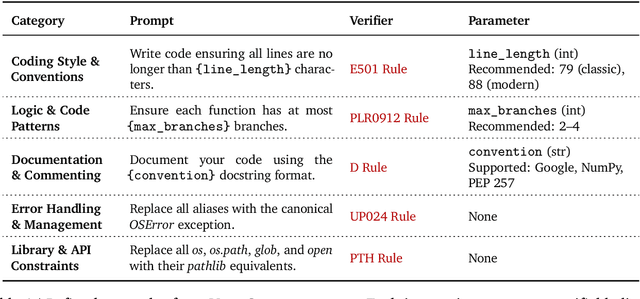
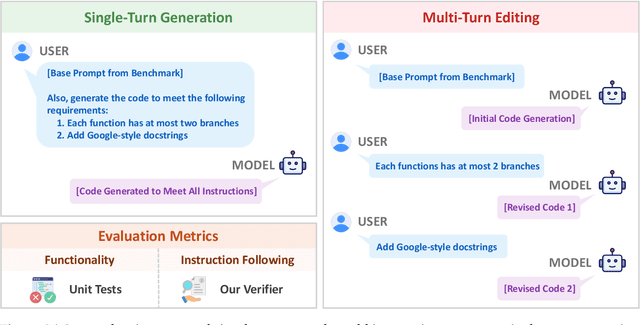
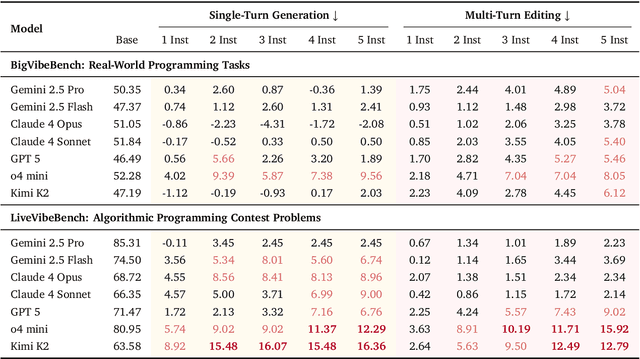
Abstract:Large Language Models (LLMs) have catalyzed vibe coding, where users leverage LLMs to generate and iteratively refine code through natural language interactions until it passes their vibe check. Vibe check is tied to real-world human preference and goes beyond functionality: the solution should feel right, read cleanly, preserve intent, and remain correct. However, current code evaluation remains anchored to pass@k and captures only functional correctness, overlooking the non-functional instructions that users routinely apply. In this paper, we hypothesize that instruction following is the missing piece underlying vibe check that represents human preference in coding besides functional correctness. To quantify models' code instruction following capabilities with measurable signals, we present VeriCode, a taxonomy of 30 verifiable code instructions together with corresponding deterministic verifiers. We use the taxonomy to augment established evaluation suites, resulting in Vibe Checker, a testbed to assess both code instruction following and functional correctness. Upon evaluating 31 leading LLMs, we show that even the strongest models struggle to comply with multiple instructions and exhibit clear functional regression. Most importantly, a composite score of functional correctness and instruction following correlates the best with human preference, with the latter emerging as the primary differentiator on real-world programming tasks. Our work identifies core factors of the vibe check, providing a concrete path for benchmarking and developing models that better align with user preferences in coding.
GRACE: Generative Representation Learning via Contrastive Policy Optimization
Oct 06, 2025Abstract:Prevailing methods for training Large Language Models (LLMs) as text encoders rely on contrastive losses that treat the model as a black box function, discarding its generative and reasoning capabilities in favor of static embeddings. We introduce GRACE (Generative Representation Learning via Contrastive Policy Optimization), a novel framework that reimagines contrastive signals not as losses to be minimized, but as rewards that guide a generative policy. In GRACE, the LLM acts as a policy that produces explicit, human-interpretable rationales--structured natural language explanations of its semantic understanding. These rationales are then encoded into high-quality embeddings via mean pooling. Using policy gradient optimization, we train the model with a multi-component reward function that maximizes similarity between query positive pairs and minimizes similarity with negatives. This transforms the LLM from an opaque encoder into an interpretable agent whose reasoning process is transparent and inspectable. On MTEB benchmark, GRACE yields broad cross category gains: averaged over four backbones, the supervised setting improves overall score by 11.5% over base models, and the unsupervised variant adds 6.9%, while preserving general capabilities. This work treats contrastive objectives as rewards over rationales, unifying representation learning with generation to produce stronger embeddings and transparent rationales. The model, data and code are available at https://github.com/GasolSun36/GRACE.
Topic Coverage-based Demonstration Retrieval for In-Context Learning
Sep 15, 2025Abstract:The effectiveness of in-context learning relies heavily on selecting demonstrations that provide all the necessary information for a given test input. To achieve this, it is crucial to identify and cover fine-grained knowledge requirements. However, prior methods often retrieve demonstrations based solely on embedding similarity or generation probability, resulting in irrelevant or redundant examples. In this paper, we propose TopicK, a topic coverage-based retrieval framework that selects demonstrations to comprehensively cover topic-level knowledge relevant to both the test input and the model. Specifically, TopicK estimates the topics required by the input and assesses the model's knowledge on those topics. TopicK then iteratively selects demonstrations that introduce previously uncovered required topics, in which the model exhibits low topical knowledge. We validate the effectiveness of TopicK through extensive experiments across various datasets and both open- and closed-source LLMs. Our source code is available at https://github.com/WonbinKweon/TopicK_EMNLP2025.
Ov3R: Open-Vocabulary Semantic 3D Reconstruction from RGB Videos
Jul 29, 2025


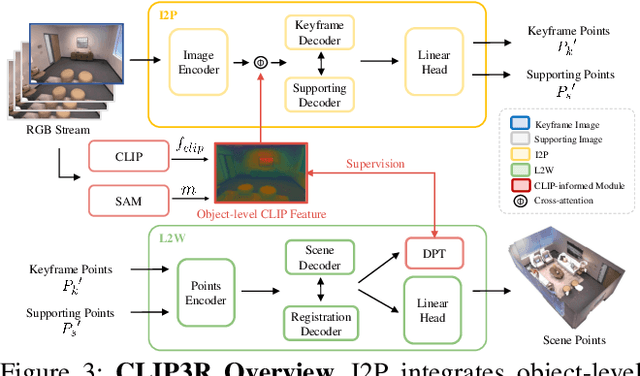
Abstract:We present Ov3R, a novel framework for open-vocabulary semantic 3D reconstruction from RGB video streams, designed to advance Spatial AI. The system features two key components: CLIP3R, a CLIP-informed 3D reconstruction module that predicts dense point maps from overlapping clips while embedding object-level semantics; and 2D-3D OVS, a 2D-3D open-vocabulary semantic module that lifts 2D features into 3D by learning fused descriptors integrating spatial, geometric, and semantic cues. Unlike prior methods, Ov3R incorporates CLIP semantics directly into the reconstruction process, enabling globally consistent geometry and fine-grained semantic alignment. Our framework achieves state-of-the-art performance in both dense 3D reconstruction and open-vocabulary 3D segmentation, marking a step forward toward real-time, semantics-aware Spatial AI.
Beyond True or False: Retrieval-Augmented Hierarchical Analysis of Nuanced Claims
Jun 12, 2025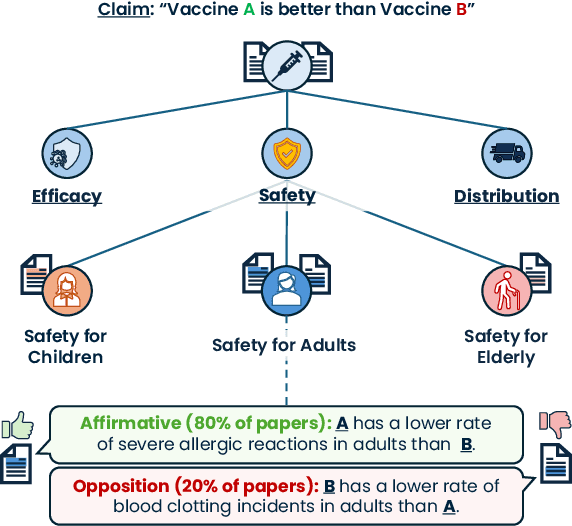
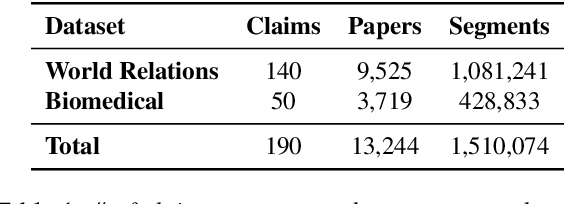


Abstract:Claims made by individuals or entities are oftentimes nuanced and cannot be clearly labeled as entirely "true" or "false" -- as is frequently the case with scientific and political claims. However, a claim (e.g., "vaccine A is better than vaccine B") can be dissected into its integral aspects and sub-aspects (e.g., efficacy, safety, distribution), which are individually easier to validate. This enables a more comprehensive, structured response that provides a well-rounded perspective on a given problem while also allowing the reader to prioritize specific angles of interest within the claim (e.g., safety towards children). Thus, we propose ClaimSpect, a retrieval-augmented generation-based framework for automatically constructing a hierarchy of aspects typically considered when addressing a claim and enriching them with corpus-specific perspectives. This structure hierarchically partitions an input corpus to retrieve relevant segments, which assist in discovering new sub-aspects. Moreover, these segments enable the discovery of varying perspectives towards an aspect of the claim (e.g., support, neutral, or oppose) and their respective prevalence (e.g., "how many biomedical papers believe vaccine A is more transportable than B?"). We apply ClaimSpect to a wide variety of real-world scientific and political claims featured in our constructed dataset, showcasing its robustness and accuracy in deconstructing a nuanced claim and representing perspectives within a corpus. Through real-world case studies and human evaluation, we validate its effectiveness over multiple baselines.
TaxoAdapt: Aligning LLM-Based Multidimensional Taxonomy Construction to Evolving Research Corpora
Jun 12, 2025Abstract:The rapid evolution of scientific fields introduces challenges in organizing and retrieving scientific literature. While expert-curated taxonomies have traditionally addressed this need, the process is time-consuming and expensive. Furthermore, recent automatic taxonomy construction methods either (1) over-rely on a specific corpus, sacrificing generalizability, or (2) depend heavily on the general knowledge of large language models (LLMs) contained within their pre-training datasets, often overlooking the dynamic nature of evolving scientific domains. Additionally, these approaches fail to account for the multi-faceted nature of scientific literature, where a single research paper may contribute to multiple dimensions (e.g., methodology, new tasks, evaluation metrics, benchmarks). To address these gaps, we propose TaxoAdapt, a framework that dynamically adapts an LLM-generated taxonomy to a given corpus across multiple dimensions. TaxoAdapt performs iterative hierarchical classification, expanding both the taxonomy width and depth based on corpus' topical distribution. We demonstrate its state-of-the-art performance across a diverse set of computer science conferences over the years to showcase its ability to structure and capture the evolution of scientific fields. As a multidimensional method, TaxoAdapt generates taxonomies that are 26.51% more granularity-preserving and 50.41% more coherent than the most competitive baselines judged by LLMs.
CC-RAG: Structured Multi-Hop Reasoning via Theme-Based Causal Graphs
Jun 11, 2025Abstract:Understanding cause and effect relationships remains a formidable challenge for Large Language Models (LLMs), particularly in specialized domains where reasoning requires more than surface-level correlations. Retrieval-Augmented Generation (RAG) improves factual accuracy, but standard RAG pipelines treat evidence as flat context, lacking the structure required to model true causal dependencies. We introduce Causal-Chain RAG (CC-RAG), a novel approach that integrates zero-shot triple extraction and theme-aware graph chaining into the RAG pipeline, enabling structured multi-hop inference. Given a domain specific corpus, CC-RAG constructs a Directed Acyclic Graph (DAG) of <cause, relation, effect> triples and uses forward/backward chaining to guide structured answer generation. Experiments on two real-world domains: Bitcoin price fluctuations and Gaucher disease, show that CC-RAG outperforms standard RAG and zero-shot LLMs in chain similarity, information density, and lexical diversity. Both LLM-as-a-Judge and human evaluations consistently favor CC-RAG. Our results demonstrate that explicitly modeling causal structure enables LLMs to generate more accurate and interpretable responses, especially in specialized domains where flat retrieval fails.
Zero-Shot Open-Schema Entity Structure Discovery
Jun 04, 2025Abstract:Entity structure extraction, which aims to extract entities and their associated attribute-value structures from text, is an essential task for text understanding and knowledge graph construction. Existing methods based on large language models (LLMs) typically rely heavily on predefined entity attribute schemas or annotated datasets, often leading to incomplete extraction results. To address these challenges, we introduce Zero-Shot Open-schema Entity Structure Discovery (ZOES), a novel approach to entity structure extraction that does not require any schema or annotated samples. ZOES operates via a principled mechanism of enrichment, refinement, and unification, based on the insight that an entity and its associated structure are mutually reinforcing. Experiments demonstrate that ZOES consistently enhances LLMs' ability to extract more complete entity structures across three different domains, showcasing both the effectiveness and generalizability of the method. These findings suggest that such an enrichment, refinement, and unification mechanism may serve as a principled approach to improving the quality of LLM-based entity structure discovery in various scenarios.
Scientific Paper Retrieval with LLM-Guided Semantic-Based Ranking
May 27, 2025Abstract:Scientific paper retrieval is essential for supporting literature discovery and research. While dense retrieval methods demonstrate effectiveness in general-purpose tasks, they often fail to capture fine-grained scientific concepts that are essential for accurate understanding of scientific queries. Recent studies also use large language models (LLMs) for query understanding; however, these methods often lack grounding in corpus-specific knowledge and may generate unreliable or unfaithful content. To overcome these limitations, we propose SemRank, an effective and efficient paper retrieval framework that combines LLM-guided query understanding with a concept-based semantic index. Each paper is indexed using multi-granular scientific concepts, including general research topics and detailed key phrases. At query time, an LLM identifies core concepts derived from the corpus to explicitly capture the query's information need. These identified concepts enable precise semantic matching, significantly enhancing retrieval accuracy. Experiments show that SemRank consistently improves the performance of various base retrievers, surpasses strong existing LLM-based baselines, and remains highly efficient.
Hypercube-RAG: Hypercube-Based Retrieval-Augmented Generation for In-domain Scientific Question-Answering
May 25, 2025Abstract:Large language models (LLMs) often need to incorporate external knowledge to solve theme-specific problems. Retrieval-augmented generation (RAG), which empowers LLMs to generate more qualified responses with retrieved external data and knowledge, has shown its high promise. However, traditional semantic similarity-based RAGs struggle to return concise yet highly relevant information for domain knowledge-intensive tasks, such as scientific question-answering (QA). Built on a multi-dimensional (cube) structure called Hypercube, which can index documents in an application-driven, human-defined, multi-dimensional space, we introduce the Hypercube-RAG, a novel RAG framework for precise and efficient retrieval. Given a query, Hypercube-RAG first decomposes it based on its entities and topics and then retrieves relevant documents from cubes by aligning these decomposed components with hypercube dimensions. Experiments on three in-domain scientific QA datasets demonstrate that our method improves accuracy by 3.7% and boosts retrieval efficiency by 81.2%, measured as relative gains over the strongest RAG baseline. More importantly, our Hypercube-RAG inherently offers explainability by revealing the underlying predefined hypercube dimensions used for retrieval. The code and data sets are available at https://github.com/JimengShi/Hypercube-RAG.
 Add to Chrome
Add to Chrome Add to Firefox
Add to Firefox Add to Edge
Add to Edge